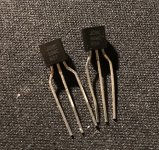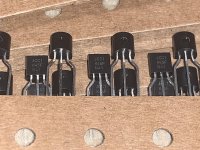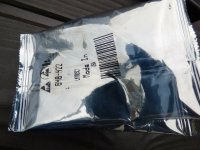How long do you keep the multimeter probes connected to the base and collector of the transistor?
Thanks
I use one of those automated device checkers. It spits a result in around 2-3 seconds.
The Elenco LCM1950 (about $100 at PE) is what I use. I have three of them, and they get used more often than the Flukes. Not only caps (and no problems for Cib and Cob - settles in on a cap value in under a second) but *inductors* too. In the time it takes to get a PC up and running to use a woofer tester I can tune in the crossover chokes I need. No self diagnostics, no windows, no internet, no updates just turn the knob and it works.
I haven’t actually tried a woofer tester to measure transistor capacitance - it probably won’t even work since they are FFT-based instead of operating at a single frequency (set by the cap itself). Couldn’t use it to sort single or double digit pF unmarked silver micas, either because of the really high Z at audio frequency. A little hand held meter is just better most of the time.
I haven’t actually tried a woofer tester to measure transistor capacitance - it probably won’t even work since they are FFT-based instead of operating at a single frequency (set by the cap itself). Couldn’t use it to sort single or double digit pF unmarked silver micas, either because of the really high Z at audio frequency. A little hand held meter is just better most of the time.
I have order IRFB4019 some time ago, but now want to use, however the tester says it are igbt,s but on resistance is still low.
I do not now if she are relabeled I need to test with current, a igbt has higher on resistances.
regards
I have look closer to this parts, and I see the on resistance is on spec and measured 85 milliohm while it is on datasheet 80 milliohms.
So for shure these are no igbt,s because these have much more on resistance what is normal for that kind of transitors.
So I think the meter do not find the real stuff.
regards.
Last edited:
Do u guys know if B&D enterprises in the US is a reliable distributor for Sanken parts eg A1668? Digikey is out of them.
Yes, it is reliable. Don't know for that specific part, but all the Toshiba JFET's they sell are genuin.
Yes, it is reliable. Don't know for that specific part, but all the Toshiba JFET's they sell are genuin.
TY!
I just use my LCR meter. I wouldn't expect more than a very approximate answer from the added capacitance function on a DMM. Again, the better the meter, the more reliable that function will be.
Hey buddy how are you doing? Long time no Chat.
Or if you happen to be in a shop somewhere, and the only thing you have to measure with is the shop keeper’s multimeter. I did this at Skycraft all the the time back in the day. Had surprisingly little trouble with fakes - most of the parts had been around since dinosaurs walked the earth.
Stupid Question... Checking the PNP 15023 works fine (503pf) with my checker going from c to b, but checking the NPN (15022) shows 276pf on c to b, but shows the right value of 500pf going from c to e (not b) .... is this normal or do I have a fake? Checking with a TC-1 device checker...
Last edited:
Does anyone else have Onsemi BC549/559Cs that look like this? I have never seen the "JC" before the transistor type, none of my other Onsemi BC549/550Cs look like that. I purchased them from RS-Components, so they should obviously be original. Were these packaged on a different plant / by a different subcontractor than the majority of these parts sold? I am just curious.
Attachments
Does anyone else have Onsemi BC549/559Cs that look like this? I have never seen the "JC" before the transistor type, none of my other Onsemi BC549/550Cs look like that. I purchased them from RS-Components, so they should obviously be original. Were these packaged on a different plant / by a different subcontractor than the majority of these parts sold? I am just curious.
These must be a certain batch (Ausulover says they're genuine, but please be aware that RS also sells CDIL generics, I have neither the experience or confidence to contradict what Asus lover says)
My recently purchased On Semi BC559CTA do not have any prefix codes, batch code is a suffix.
I presume that OnSemi and other OEMs are changing batch markings much more often now, to combat fakes
Last edited:
Does not look like a 250w die to me.... maybe 100-125w, even 150w dies are larger... but this is me old school eyes...MJ15003
Anyone know if this is a genuine Motorola MJ15003 or a fake.
Here's an odd one for discussion if you will.
I ordered some B772 BJTs, judging by the sellers photographs, these were generics.
They were cheap and I wasn't expecting much.
A month later and I start to think they will never arrive.
They arrived today.
They do not match the photos at all, and are actually marked as NEC devices.
Are these genuine? Can it be?

I ordered some B772 BJTs, judging by the sellers photographs, these were generics.
They were cheap and I wasn't expecting much.
A month later and I start to think they will never arrive.
They arrived today.
They do not match the photos at all, and are actually marked as NEC devices.
Are these genuine? Can it be?
AND put out a full1.5 amp. Fake voltage regulators are usually real ones with the smaller version (78M05 or even L05) in them. Put it on a 12 volt bench supply and measure the short circuit current (when on a heat sink). At 7 volts differential you should get the full max current. Even if undersized you can’t damage these regulators with anything other than overvoltage, so SOA testing is easy.
The LM340 series has tighter regulations specs, so a 340-T5 could legitimately be sold as a 7805.
And linear VRs are inexpensive enough and demand is on its way down rather than up so you do stand a decent chance of receiving a real one.
The LM340 series has tighter regulations specs, so a 340-T5 could legitimately be sold as a 7805.
And linear VRs are inexpensive enough and demand is on its way down rather than up so you do stand a decent chance of receiving a real one.
- Home
- Design & Build
- Parts
- My Transistors, original or copy?


